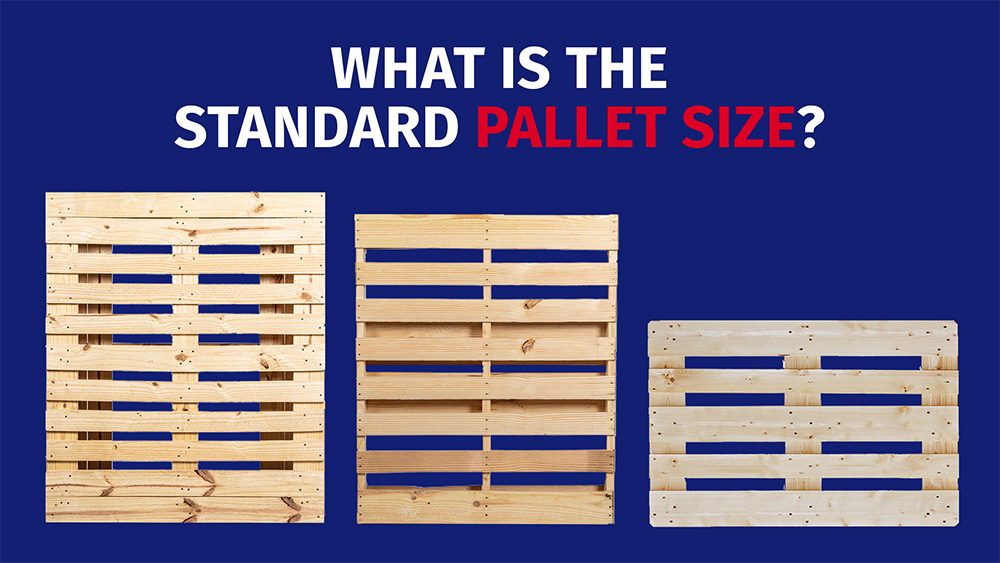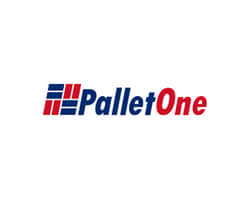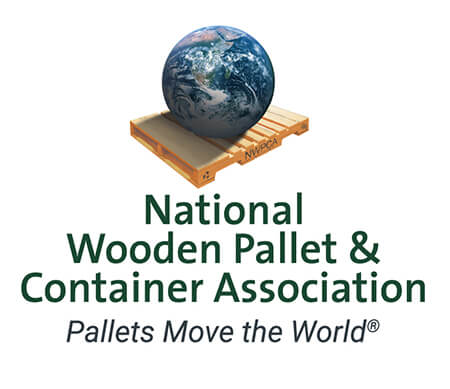The idea of a Standard Pallet Size is a tricky one. Depending on where you are and what industry you’re serving, “Standard” can mean something very different. In North America, the 48×40″ GMA style pallet is the first to jump to mind.
North American Pallets
North American usage of this size is driven by the food and beverage industry. This size is also commonly used across other industries. It aligns well with door widths and truck sizes, in addition to being widely available in the used pallet market.
Pallet Dimensions
Industry Used
48 x 40
Grocery and other FMCGs
40 x 40
Dairy
36 x 36
Beverage
48 x 20
Retail
48 x 36
Beverage, Packaged Paper, Shingles
48 x 42
Beverage, Chemical
48 x 45
Automotive
40 x 48
Military, Cement
35 x 45.5
Military
44 x 44
Chemical, Drums
48 x 48
Drums
42 x 42
Paint, Telecom
European Pallets
In Europe, the European Pallet Association (EPAL) regulates the euro block pallet, an 800 x 1200 mm model, slightly smaller than its American counterpart. (By comparison, the GMA pallet measures 1219 x 1016 mm.) The euro pallet size is considered a standard in Europe and is popular due to its durability, standardization, and ease of exchange across various industries. According to a 2020 report, it accounted for 21% of new pallet production in Europe.
Another variant, the 1000 x 1200 mm industrial pallet, caters to the chemical industry. The 1200×100 mm block pallet is also the standard size for consumer products in the U.K. The ‘pooling’ concept is strong in Europe, thanks to EPAL and other pallet pools.
EURO
Pallet Type
Pallet
Dimensions
ISO Pallet Alternative
EUR/EUR 1
800 mm × 1200 mm
(31.50” × 47.24”)
ISO1, same as EUR
EUR 2
1200 mm x 1000 mm
(47.24” × 39.37”)
ISO2
EUR 3
1000 mm × 1200 mm
(39.37” × 47.24”)
EUR 6
800 mm × 600 mm
(31.50” × 23.62”)
1100 mm x 1100 mm
(43.30” x 43.30”)
ISO0,
1/2 of EUR
600 mm × 400 mm
(23.62” × 15.75”)
1/4 of EUR
400 mm × 300 mm
(15.75” × 11.81”)
1/8 of EUR
Popular Pallets Around The World
In Asia, two noteworthy pallet sizes are the 1100 x 1100 mm, widely used in Japan and other countries, and the 1200×1000. The 1200×1000 pallet has become an increasingly popular choice in countries such as China and India with modern supply chain infrastructure growth. The 1219 x 1016 mm size is popular for export, aligning with the global shipping standard of 20- and 40-foot shipping containers and its compatibility with North American customers.
In contrast to Asia’s diversity, Australia, has largely standardized around the Australian Standard Pallet size of 1165 x 1165 mm. However, an increasing amount of international trade has increased the use of Euro and GMA-size pallets too.
On the African continent, there is a significant variety of pallet sizes. However, there has been a growing move towards aligning with the Euro and GMA standard sizes, especially for international shipping.
ISO Pallets
The need for standardization goes beyond any single nation. After World War II the newly-formed International Organization for Standardization (ISO) created a series of global standards for standardization in all technical and nontechnical fields, including pallets.
Pallet Dimensions
Regions Used
1016 mm x 1219 mm
(40″ x 48″)
North America
1067 mm x 1067 mm
(42” x 42”)
North America, Europe, Asia
1000 mm x 1200 mm
(39.27” x 47.24”)
Europe, Asia
800 mm x 1200 mm
(31.5” x 47.24”)
Europe
1165 mm x 1165 mm
(45.9” x 45.9”)
Australia
1100 mm x 1100 mm
(43.3” x 43.3”)
Asia
Chemical Pallets
The chemical industry developed the CP pallet specification. The CP pallet program is overseen by PlasticsEurope, a European trade association that authorizes select companies to produce CP pallets. There are nine different models available to meet the specific needs of the chemical and polymer industries.
Pallet Dimensions
Common Uses
Defining Factors
CP1
1200 mm x 1000 mm
(47.24” x 39.37”)
Best for boxes and bags or sacks of raw materials
These skids do not have a bottom deck board and are fitted with runners.
CP2
1200 mm x 800 mm
(47.24” x 31.5”)
Used to transport canisters, boxes, and fiber drums.
These skids have three runners.
CP3
1140 mm x 1140 mm
(44.88” x 44.88”)
Ideally suited to transporting bags, barrels, and octabins.
This is a square skid, which has three runners.
CP4
1100 mm x 1300 mm
(43.3” x 51.18”)
Designed for sacks of raw materials.
This skid has three runners and a wider lead or edge board.
CP5
760 mm x 1140 mm
(29.92” x 44.88”)
Made for transporting small boxes and cartons.
This is a smaller skid, which has three runners and no bottom deck board.
CP6
1200 mm x 1000 mm
(47.24” x 39.37”)
Best for sacks and boxes.
This pallet has a bottom deck board, which facilitates easy stacking.
CP7
1300 mm x 1100 mm
(47.24” x 51.18”)
Used to transport sacks.
These pallets have bottom deck boards, which makes stacking effortless.
CP8
1140 mm x 1140 mm
(44.88” x 44.88”)
Designed to transport sacks and octabins.
These are square pallets with bottom deck boards, which are characterized by a gap in the center for drainage.
CP9
1140 mm x 1140 mm
(44.88” x 44.88”)
Ideal for bulk containers and drums.
These are the same as CP8 pallets without the hole for drainage.
Why Do Standard Pallet Sizes Matter?
This information can seem unnecessarily complex, but the standardization of pallet sizes is integral to the easy flow and optimization of nearly every supply chain worldwide. Knowing the standard pallet sizes for your industry can help you streamline pallet transport and selection, as well as reduce costs associated with having to return non-standardized pallets. This is especially true if you are shipping internationally.
The optimization of space and cost efficiency benefits everyone in the supply chain from manufacturer to consumer. Standardizing pallet sizes makes sure your products fit in trucks, warehouses, and other locations along the way. This helps reduce shrinkage and damage to goods while optimizing transport costs.
Even if you are using a custom pallet, internal standardization matters as well. Standard pallet sizes enable the optimization of all your material handling equipment to align with a single platform. This optimization extends to warehouse storage and transportation, allowing you to maximize the number of pallets on a truck or in your storage space.
Furthermore, if your production processes involve automation, the use of standard-sized pallets ensures a seamless flow throughout the line, eliminating the need for adjustments due to varying pallet sizes.
Setting The Right Standard For Your Product
While standard sizes make freight and reuse less complicated overall, one-size-fits-all does not always apply to pallets. The best pallet is almost always the pallet designed specifically for your product.
Custom pallets usually come with a higher price tag, but that investment pays off in the form of increased reliability and decreased product loss while also protecting your employees from the dangers of an ill-suited, unstable pallet.
Our Unit Load Design experts don’t just take your product and your pallet into consideration, they look at everything: shipping methods, storage conditions, pallet re-use needs, other packaging supplies like shrink wrap or corrugated stabilizers, and more, to give you a total packaging solution to provide you an optimized packaging solution.
Partnering with a supplier who does a proper packaging consultation is key to determining if a standard pallet can properly meet your needs. PalletOne’s Pallet Concierge™ program takes this a step further, finding the perfect pallet for your product and giving you full access to the first wholly owned national pallet supplier with a single, easy-to-reach, point of contact. Contact us today to find out how Pallet Concierge™ can solve your pallet problems.












